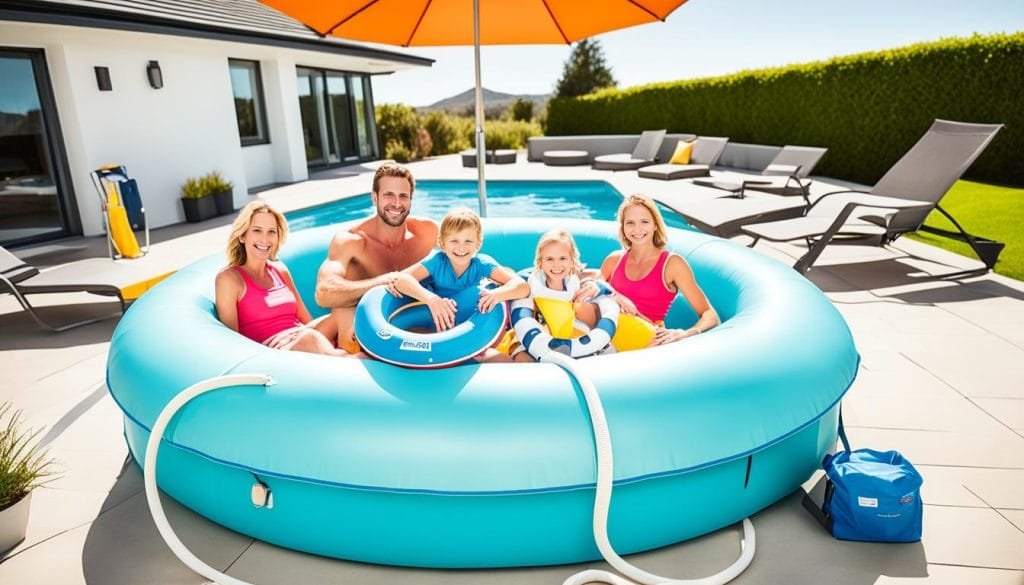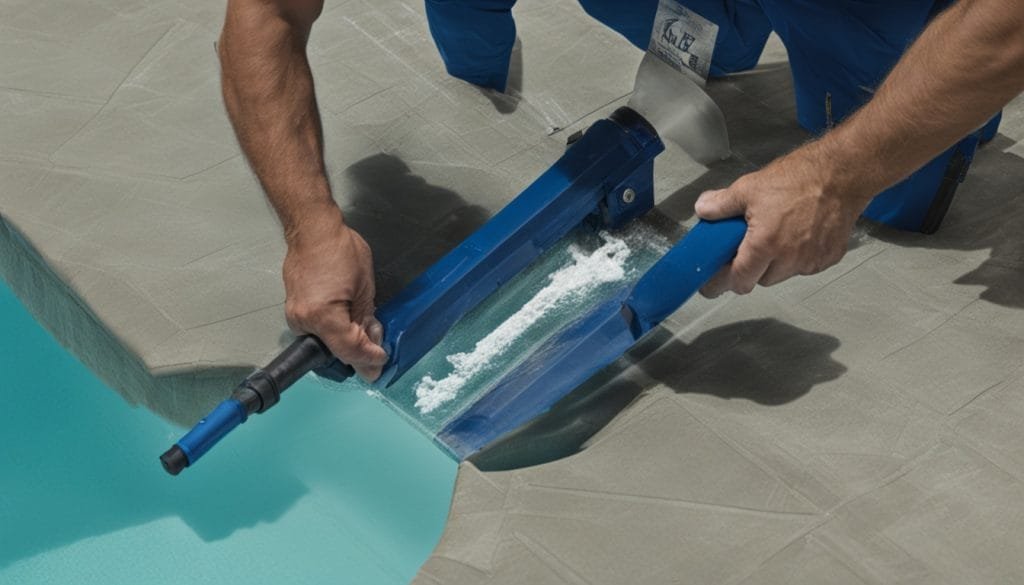Ensuring pool cover safety is vital for our loved ones. Swimming pool safety covers are key in reducing risks linked with pool ownership. Every year, we see the dangers from not having enough safety measures. Knowing how to install and maintain them properly can save lives, making the best pool cover for safety a must-have.
Key Takeaways
- Up to 20% energy savings are achievable through the use of pool covers.
- Regular maintenance extends the lifespan of pool covers beyond five years.
- Well-installed motorised pool covers are recommended for larger pools.
- Most drownings involve children under five who are unsupervised.
- Pool chemicals must be properly stored and handled to prevent accidents.
- Proper fencing and alarms enhance pool safety significantly.
- Swimming lessons should begin as early as one year of age.
Introduction to Pool Cover Safety
Keeping our pools safe is very important for all pool owners. Using top-notch safety covers is a great way to boost safety. These covers help save energy and keep our pools clean by stopping debris and unwanted access. It’s key to know how vital pool covers are and the dangers of pool use to make our pools safer.
Understanding the Importance of Pool Covers
Safety pool covers can save a lot of money, especially for big pools that don’t need to drain water every season. They make pools last longer by cutting down on repainting and replastering. Brands like Loop-Loc use a special measuring process for a perfect fit, and Merlin uses CAD tech for custom designs. This means even odd-shaped pools get the right protection.
Common Risks Associated with Pool Use
Not having the right safety can lead to serious accidents, like drowning in children. Always watching the pool is a must, but we also need to follow pool cover safety rules. Badly managed pools have seen more deaths, making a good safety cover a smart choice. Plus, they might even lower insurance costs for pool owners.
Types of Pool Covers
Choosing the right pool cover is key to keeping our pools safe and functional. Each type has unique benefits and safety features for different needs. Let’s look at the main options we have.
Safety Covers
Safety covers are known for their strong design. They can hold the weight of a person, preventing drowning. This makes them vital for keeping our kids safe around the pool.
The PowerPlastics Solid Safety Cover is a great example. It’s made to last and can hold over 225 kg. It also has a secure lock and drains water to stop it from building up. Plus, it comes with a one-year warranty for peace of mind.
Solar and Automatic Covers
Solar covers help save on heating costs and cut down on evaporation. They keep the pool warm in the cold months. But, they don’t have the same safety level as safety covers. They’re more affordable but need some upkeep.
Automatic covers make it easy to open or close the pool with just a button. They fit any pool shape and can also be a safety feature. But, they need regular checks to keep them working well.
| Type of Cover | Safety Rating | Heat Retention | Average Price |
|---|---|---|---|
| Safety Cover | High | Low | High |
| Solar Cover | Medium | High | Moderate |
| Automatic Cover | Medium-High | Medium | Very High |
| Winter Cover | Low | Low | Low |
Choosing the right pool cover means balancing safety and practicality. Knowing what each type offers helps us make smart choices for our pools. This ensures our families stay safe and comfortable.
Pool Cover Safety Guidelines
Keeping our swimming pools safe is a big responsibility. Following pool cover safety guidelines is key to protecting our loved ones, especially kids, from accidents. It’s important to check and maintain pool covers often. Also, picking the right cover boosts safety and makes it work better.
Regular Inspections and Maintenance
Checking our pool covers often is crucial for their longevity and safety. We should look for any damage and make sure straps and anchors are tight. Cleaning the covers every month stops bacteria and gets rid of algae or dirt. These steps are key to safety.
Choosing the Right Cover for Safety
It’s vital to pick a cover that’s at least 4-8mm thick for safety and to keep the pool warm. A good fit means it can hold the weight of two adults and a child, preventing accidents. Make sure it’s installed right, focusing on good drainage and keeping moisture out. For the best advice, check the pool safety standards for top safety tips.

| Feature | Description |
|---|---|
| Material | 550-600 gsm PVC with aluminum battens |
| Weight Capacity | Supports the weight of two adults and a child |
| Warranty | 1-year warranty, expected lifespan of 5 years |
| Drainage System | Includes holes to prevent water accumulation |
| Installation | Must be done by authorized installers |
| Cost | Prices range from R6000 to R15000 |
Installation and Removal Best Practices
Proper installation and removal of pool covers are key for safety and efficiency. These steps help keep our pools safe and well-kept. By using the right methods, we can get the most out of our pool covers.
Proper Installation Techniques
When putting in a pool cover, we must follow British Standards. Choosing quality materials stops corrosion and makes the cover last longer. It’s vital that the cover fits well; a loose one can be dangerous. Also, motorised covers should let us take them off by hand if needed, so we can act fast if there’s a problem.
Safe Removal Procedures
Before taking off the cover, make sure there are no swimmers around. Keeping the area safe is key to removing the cover right. We should also get rid of any water and debris on the cover for safe storage. When lifting the cover, we must hold it properly to avoid damage or accidents. If we ignore these steps, we could face risks or damage the cover.

| Installation Practices | Removal Practices |
|---|---|
| Follow British Standards for installation | Ensure area is clear of swimmers |
| Use quality, corrosion-resistant materials | Remove debris and water before lifting |
| Ensure covers fit securely without sagging | Support cover adequately while lifting |
| Allow for manual removal on motorised covers | Store the cover in a clean, dry area |
Following these steps makes our pool safer and more efficient. Knowing about pool cover safety helps us handle any problems that come up.
Read more about pool coversafety to learn more and improve our methods.
Operational Safety for Pool Covers
Ensuring pool cover safety means training staff well and having clear emergency plans. This helps follow pool cover safety rules, making the area safer.
Staff Training and Safety Protocols
All staff need thorough training on how to use pool covers safely. They learn the right ways to handle covers and why safety rules are key. Regular training keeps their skills sharp, boosting confidence and lowering accident risks.
Emergency Procedures and Action Plans
An Emergency Action Plan (EAP) should list steps for incidents with the pool cover. For example, if someone falls on the cover, quick actions can prevent injury. It’s also key to watch over cover operations to avoid equipment problems. Only certain people should have the keys to the cover, ensuring safety and following the rules.
The table below shows important safety steps and guidelines for pool covers:
| Aspect | Requirements |
|---|---|
| Compliance | Percentage of pool covers must meet ASTM Standard F-1346-91 requirements. |
| Storage | Pool cover should be stored at least 3 feet away from the pool when not in use. |
| Deck Track Height | Height limit for tracks on the deck surface must not exceed 3 inches. |
| Switch Installation | Activating switch for pool cover mechanisms must ensure clear visibility of pool surface. |
| Thickness of Housing Cover | Housing cover for sub-surface units should not exceed 2 inches in thickness from the pool edge. |
| Key Access | Only responsible parties should have access to keys for the pool cover mechanisms. |
Putting safety first in our training and emergency plans reduces risks around pool covers. Keeping up with these areas shows our dedication to top pool cover safety rules.
Additional Safety Measures
To make sure swimming is safe, we need to think about more than just pool covers. We should look at fencing, alarms, and teach family and guests about pool safety. These steps greatly lower the risks when using the pool, especially for kids.
The Role of Fencing and Alarms
A strong fence with a self-latching gate is key to keeping kids out of the pool area. It stops accidents from happening. Adding pool alarms also helps by alerting us if someone is near the pool. This keeps us alert and safe.
Educating Family and Guests about Safety
It’s important to teach everyone who uses the pool about safety rules. Showing emergency contacts and pool rules helps everyone stay safe. Making sure everyone knows the dangers can really cut down on risks.
Conclusion
Keeping our pools safe is key to protecting our loved ones and guests from hidden dangers. By choosing the right pool covers and looking after them well, we can lower the risks. This is especially important in places with lots of snow or rain, where the wrong covers can collapse.
We also need to watch out for dangers like getting trapped or slipping. Checking and looking after our pool covers regularly is crucial. This makes sure they work right and stay safe. By being proactive and choosing safe pool covers, we can make our pools fun and safe for everyone.
Staying focused on pool safety helps keep our families safe and saves money on energy and water. Let’s all work together to make sure our pools are safe and fun for everyone.

